Kashyapa Shilpa-shastra (study)
by K. Vidyuta | 2019 | 33,520 words
This page relates ‘Fourteen types of Ayatashra (Rectangular) Mandapas’ of the study on the Kashyapa Shilpa-shastra (in English) with special reference to the characteristics of Prakara (temple-components), Mandapa (pavilions) and Gopura (gate-house). The Silpa-Sastras refers to the ancient Indian science of arts and crafts, such as sculpture, architecture and iconography. This study demonstrates the correlatation between ancient Indian monuments (such as temples and sculptures) and the variety of Sanskrit scriptures dealing with their construction.
5. Fourteen types of Āyatāśra (Rectangular) Maṇḍapas
The āyatāśra maṇḍapa has the same number of paṅktis in breadth and length. Increasing by 3 aṅgulas, the paṅktis are extended till 27 aṅgulas, thus resulting in 9 types of measures.
The increase or decrease in the measurements therefore depends upon the type of maṇḍapa that is to be designed (XLIV. 64-5):
vistāraṃ paṅktitulyeva sāyataṃ vātha paṅktayaḥ |
vistārapaṅktimānaṃ tu guṇāṅgulavivardhanāt ||
saptaviṃśāṅgulaṃ yāvattāvadāyamaṃ navadhoditam |
vardhanaṃ vā kṣayaṃ vāpi maṇḍapena karoditam ||[1]
The hasta māna must not be used for measuring the pūrvamaṇḍapa and as described earlier the paṅktis of the maṇḍapas must have pillars.
A desired length which is also auspicious is taken as the length of the maṇḍapa and this must be divided into appropriate parts and then the maṇḍapa must be constructed (XLIV. 66-7)[2] :
nāśrayettu karaṃ pūrvaṃ maṇḍapaṃ tu samācaret |
aśeṣapaṃktisaṃkhyāsu prāgvadāyādimācaret ||
bhaktisaṃkhyāsamopetaṃ maṇḍapasya tadāyatam |
tasyocitavibhāgaṃ tu kṛtvā vā maṇḍapaṃ kuru ||
(i). First maṇḍapa
 This maṇḍapa is 3 paṅkti measure in breadth and 5 paṅkti measure in length; on either side or in front, a doorway (vāra or dvāra) is designed in 1 (one) part. So, if there is a door on the 3 sides then it must be endowed with 30 pillars. These pillars are added around the maṇḍapa on the outside or inside and 28 pillars must be embellished with lūpas (XLIV. 68-70ab)[3] :
This maṇḍapa is 3 paṅkti measure in breadth and 5 paṅkti measure in length; on either side or in front, a doorway (vāra or dvāra) is designed in 1 (one) part. So, if there is a door on the 3 sides then it must be endowed with 30 pillars. These pillars are added around the maṇḍapa on the outside or inside and 28 pillars must be embellished with lūpas (XLIV. 68-70ab)[3] :
paṃktitrayaviśālaṃ tu pañcapaṃktyā viśālakam |
ekapārśve pure vātha dvāramaṃśena kalpayet ||
pārśve vārayutaṃ cettu triṃśadaṅghrisamanvitam |
tadeva paritoṃ'śena maṇḍapābhyantarasya ca ||
lūpārohaṇakaṃ kuryāt aṣṭāviṃśāṃghrisaṃyutam |
If there is a doorway only in the front then it must be accompanied by 26 pillars; but if there is no doorway then that maṇḍapa must contain 24 pillars each of which is well decorated with alpanāsikās.
The maṇḍapa must also constitute the vedikās, jālakas, toraṇas and kumbhalatās (XLIV. 70cd-72ab)[4] :
puro vārayutaṃ cet tat ṣaḍviṃśat caraṇānvitam ||[5]
athavā vārahīnaṃ tu triraṣṭacaraṇānvitam |
pādaṃ pratyalpanāsāḍhyaṃ vedijālakatoraṇam ||
nānākuṃbhalatādyaistu kalpitaṃ prathamaṃ bhavet |
(ii). Second maṇḍapa
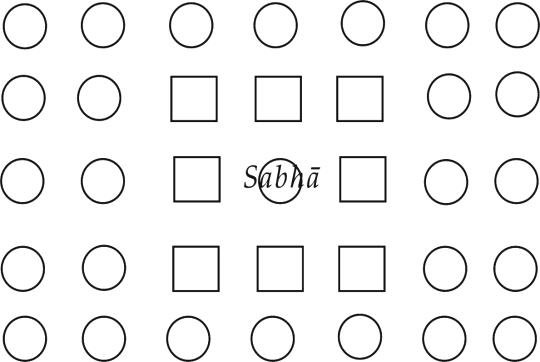 The next type of rectangular maṇḍapa should measure 4 paṅkti in breadth, 6 paṅkti in length and 1 paṅkti all around. At the centre of the maṇḍapa a kūṭa is established measuring 2 paṅktis wide and it also has a mukhabhadra of 1 paṅkti measure.
The next type of rectangular maṇḍapa should measure 4 paṅkti in breadth, 6 paṅkti in length and 1 paṅkti all around. At the centre of the maṇḍapa a kūṭa is established measuring 2 paṅktis wide and it also has a mukhabhadra of 1 paṅkti measure.
This second type of maṇḍapa has 32 columns (XLIV. 72cd-74ab):
caturbhaktiviśālaṃ tu āyāme tu ṣaḍaṃśakam ||
maṇḍapaṃ paritoṃśena kūṭamabhyantaretaram |
dvibhaktivistṛtaṃ caikabhaktyā tu mukhabhadrakam ||
dvātriṃśat caraṇopetaṃ maṇḍapasya dvitīyakam |
(iii). Third maṇḍapa
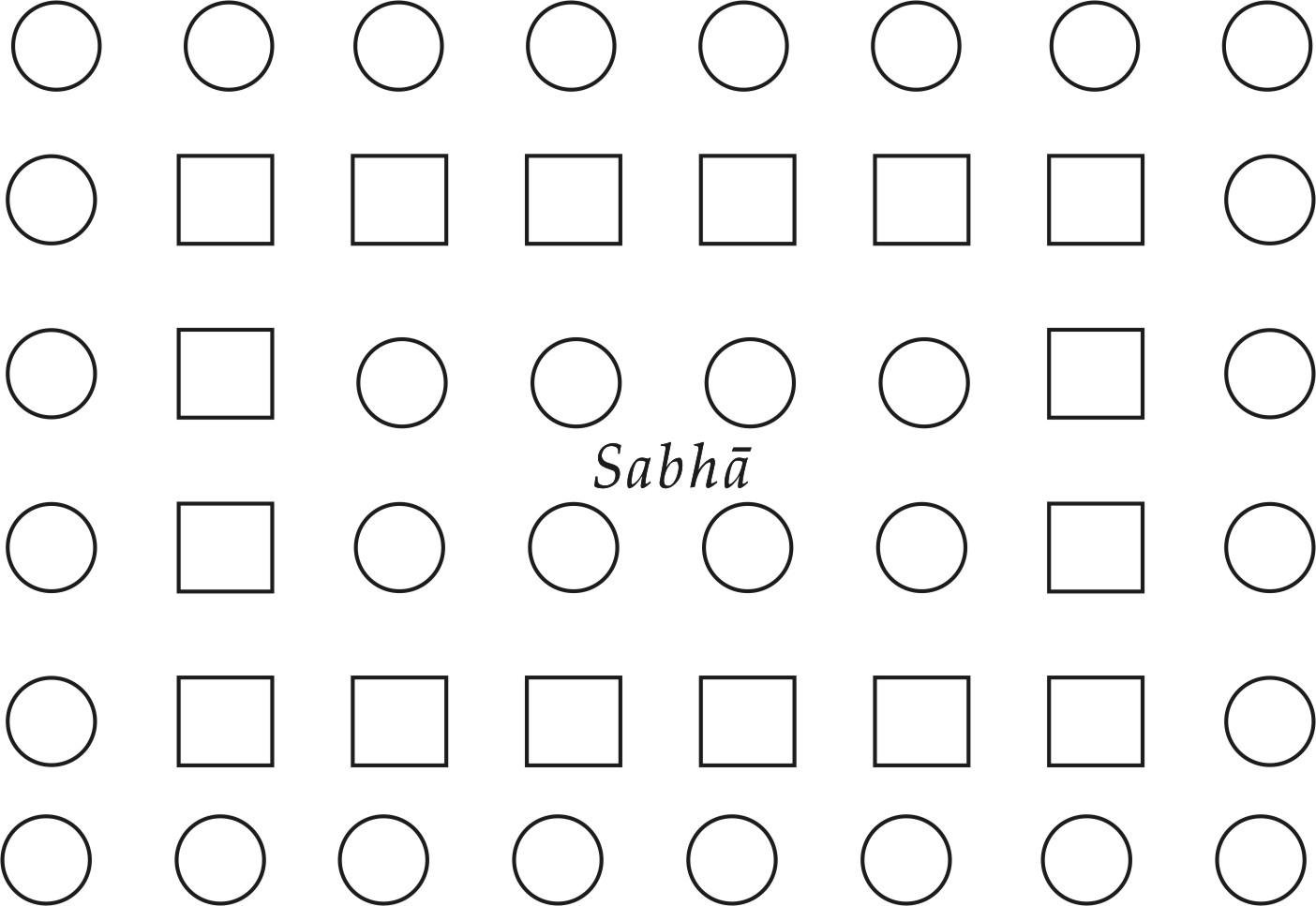 The third type of maṇḍapa should measure 5 paṅktis in width and 7 paṅktis in length. In the centre of this, a sabhā of 3 paṅktis width and 5 paṅktis length should be designed; around the maṇḍapa a bhadra of 1 paṅkti measure in the desired direction must be constructed.
The third type of maṇḍapa should measure 5 paṅktis in width and 7 paṅktis in length. In the centre of this, a sabhā of 3 paṅktis width and 5 paṅktis length should be designed; around the maṇḍapa a bhadra of 1 paṅkti measure in the desired direction must be constructed.
Moreover, this manḍapa must constitute 40 pillars and must be well ornamented with vedikās, etc. (XLIV. 74cd-6):
viśālaṃ pañcabhaktyā syādāyāme saptabhaktayaḥ ||
tripañcapaṅktivistāradīrghā madhye sabhā bhavet |
maṇḍapaṃ paritoṃśena iṣṭadigbhadrasaṃyutam ||
catvāriṃśat pādāḍhyaṃ sarvālaṃkārasaṃyutam |
vedikādyaiḥ samāyuktaṃ tṛtīyaṃ maṇḍapaṃ bhavet ||
(iv). Fourth maṇḍapa
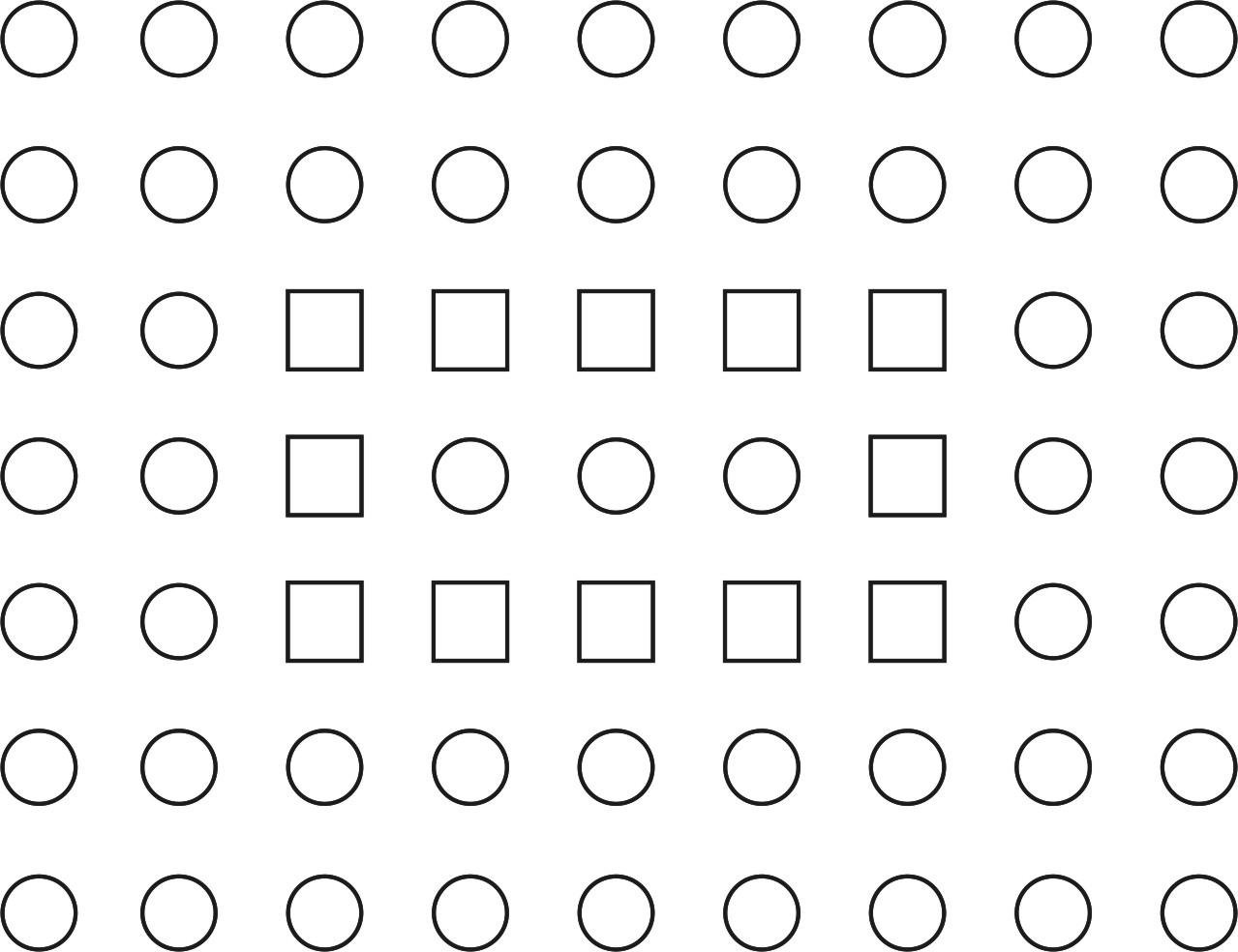 Measuring 6 paṅktis wide and 8 paṅktis long, this type, has a sabhā which is 2 paṅkti in width and 4 paṅkti long. The maṇḍapa is to be surrounded by, in the desired direction mukhabhadras of 2 paṅkti measure.
Measuring 6 paṅktis wide and 8 paṅktis long, this type, has a sabhā which is 2 paṅkti in width and 4 paṅkti long. The maṇḍapa is to be surrounded by, in the desired direction mukhabhadras of 2 paṅkti measure.
Also, this has 60 pillars, well decorated with nāsikās, etc. and is endowed with ornamental mouldings (XLIV. 77-8):
rasabhaktiviśālaṃ tu vasubhaktyāyataṃ bhavet |
dvicaturbhaktivistāradīrghaṃ madhye sabhodayam ||
maṇḍapaṃ parito'kṣāṃśaṃ iṣṭadiṅmukhabhadrakam |
ṣaṣṭisaṃkhyāṅghrisaṃyuktaṃ nāsikādi vibhūṣitam ||[6]
nānālaṅkārasaṃyuktaṃ caturthaṃ maṇḍapaṃ bhavet ||
(v). Fifth maṇḍapa
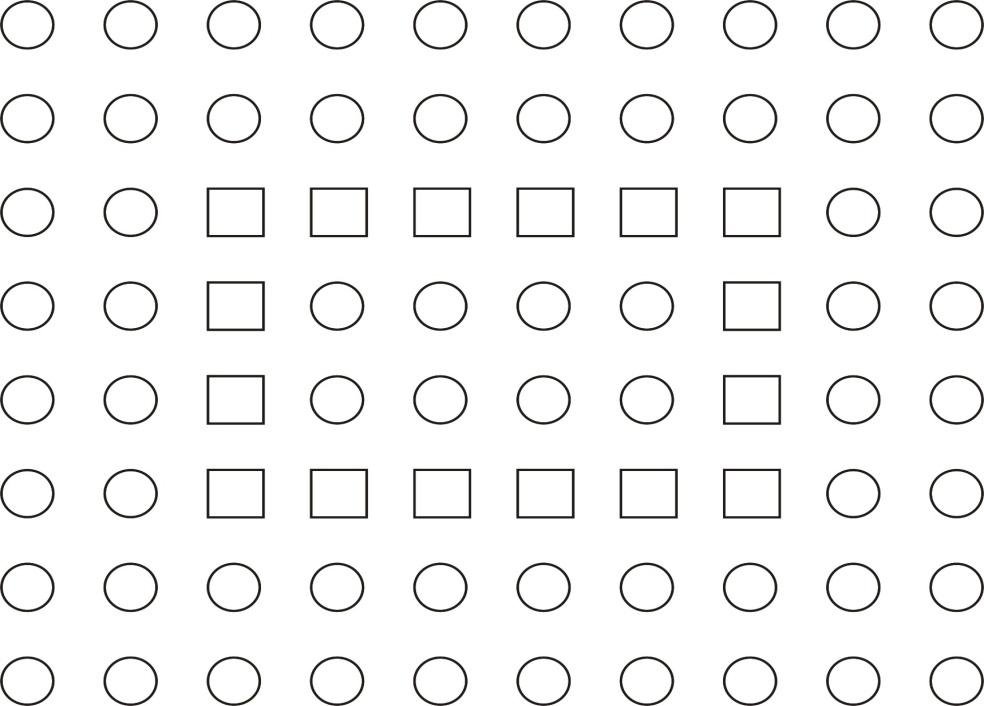 This rectangular maṇḍapa is 7 paṅktis in width and 9 paṅkti in length. The sabhā in the middle, with 3 paṅkti wide and 5 paṅkti long must be constructed. Surrounding the maṇḍapa or in any desired direction a 2 paṅkti measure bhadra must be built and a mukhabhadra of 3 paṅkti width and 1 paṅkti length must also be established.
This rectangular maṇḍapa is 7 paṅktis in width and 9 paṅkti in length. The sabhā in the middle, with 3 paṅkti wide and 5 paṅkti long must be constructed. Surrounding the maṇḍapa or in any desired direction a 2 paṅkti measure bhadra must be built and a mukhabhadra of 3 paṅkti width and 1 paṅkti length must also be established.
Furthermore, this 5th rectangular maṇḍapa should have 72 pillars and must be well embellished (43. 100-02)[7] :
tāre saptavibhāge tu navabhaktyāyatānvitam |
tribhaktivistṛtaṃ pañcabhaktyāyāmaṃ sabhāṃkaṇam ||
maṇḍapaṃ paritokṣāṃśaṃ iṣṭadigbhadrasaṃyutam |
tribhaktivistṛtaṃ caikabhaktyāyāmamukhabhadrakam ||
saptatiḥ syāddvayādhikyaṃ pādamityabhidhīyate |
sarvālaṃkārasaṃyuktaṃ pañcamaṃ maṇḍapaṃ bhavet ||
(vi). Sixth maṇḍapa
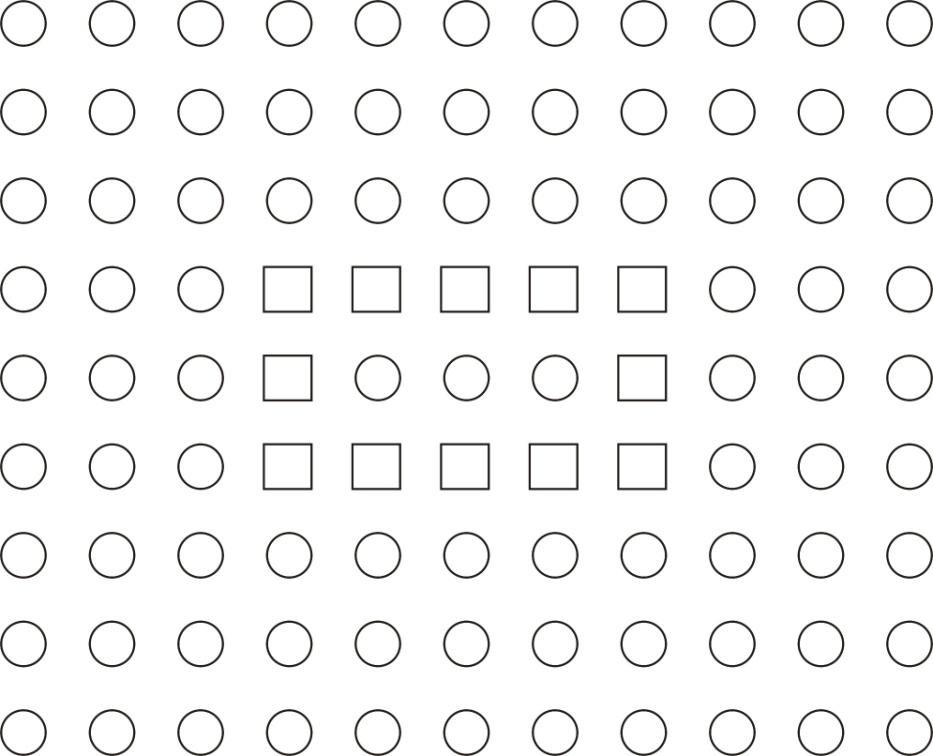 The next maṇḍapa should measure respectively 8 and 10 paṅktis in breadth and length; the sabhā in its midst with 2 and 4 paṅktis in dimension has a 3 paṅkti space around it with pillars in the centre. Also, in any desired direction a mukhabhadra of 4 paṅkti width and 2 paṅkti length can be constructed.
The next maṇḍapa should measure respectively 8 and 10 paṅktis in breadth and length; the sabhā in its midst with 2 and 4 paṅktis in dimension has a 3 paṅkti space around it with pillars in the centre. Also, in any desired direction a mukhabhadra of 4 paṅkti width and 2 paṅkti length can be constructed.
This maṇḍapa consisting of 96 pillars, is well decorated and this type of maṇḍapa is favourable especially for Lord Śiva (XLIV. 81cd-4ab)[8] :
vasubhaktiviśālaṃ tu daśabhaktyāyatānvitam ||
dvicaturbhāgavistāraṃ dīrghamadhye sabhodayam |
parito maṇḍapo'gnyaṃśa madhyastambha vivarjitam ||
iṣṭadiṅmukhabhadrāṃśaṃ caturdvyaṃśe ca suvrata |
ṣaṇṇavatyaṅghrisaṃyuktaṃ sarvālaṃkārasaṃyutam ||
ṣaṣṭhamaṃ maṇḍapaṃ hyevaṃ procyate tu śivārhakam |
(vii). Seventh maṇḍapa
Seventh type of rectangular maṇḍapa measures 11 paṅktis long and 9 paṅktis wide; the centre is adorned by a sabhā that is 1 and 3 paṅktis in breadth and length and all around the maṇḍapa there must be a measure of 4 paṅktis. The mukhabhadra of this maṇḍapa should measure 3 and 4 paṅktis in extent.
Similar to all other types this maṇḍapa is also to be nicely decorated (XLIV. 84cd-6)[9] :
navabhaktyā viśālaṃ tu rudrabhaktyāyatānvitam ||
ekatribhaktivistāraṃ dīrghamadhye sabhā bhavet |
parito vedabhāgaṃ tu maṇḍa paṃ parikalpayet ||
tricaturbhāgavistāraṃ dīrghaṃsyānmukhabhadrakam |
sarvālaṃkārasaṃyuktaṃ saptamaṃ maṇḍapaṃ bhavet ||
(viii). Eighth maṇḍapa 39
This type measures 10 paṅktis broad and stretches up to 12 paṅktis. The sabhā in the midst of the maṇḍapa ought to measure 2 paṅkti long and 4 paṅkti wide; surrounding the sabhā an alinda of 1 paṅkti measure must be constructed and if alinda is outside the maṇḍapa then it must measure 2 paṅktis. To the exterior of these a portico of a paṅkti measure, having pillars has to be designed and this maṇḍapa should have bhadras in the desired directions (43. 108cd-10):
Only the Muktabodha edition has the entire description of all the 14 types of rectangular manḍapas and so the description of 8-14th type maṇḍapa is taken from Muktabodha edition.
daśabhaktyā viśālaṃ tu dvibhaktyedhikamāyatam ||
dvicaturbhāgāyataṃ tāraṃ tayormadhye sabhāṃkaṇam |
parito'lindamekāṃśaṃ maṇḍapāddvyaṃśabāhyataḥ ||
tadbāhye'lindamekāṃśaṃ yuktyāntastambhasaṃyutam |
iṣṭadigbhadrasaṃyuktaṃ aṣṭamaṃ maṇḍapaṃ bhavet ||
(ix). Ninth maṇḍapa
This maṇḍapa measures 11 and 13 paṅktis in width and length. The sabhā inside it; measures 3 paṅktis in dimension; surrounding this, an alinda of 1 (one) paṅkti measure must be constructed and if alinda is outside the maṇḍapa then it must measure 2 paṅktis.
Furthermore, the ninth maṇḍapa must have a portico of 1 (one) paṅkti outside of it (43. 111-12ab):
tadeva śivāṃśādhikaṃ vistṛtāyāme tripañcāṃśena sabhāṃkaṇam |
parito'lindamekāṃśaṃ maṇḍapaṃ dvyaṃśabāhyataḥ ||
tadbāhye'lindamekāṃśaṃ navamaṃ maṇḍapaṃ bhavet |
(x). Tenth maṇḍapa
Measuring 12 and 14 paṅktis wide and long respectively, this maṇḍapa, also consists of a central sabhā measuring 4 and 6 paṅktis. Outside the sabhā, an alinda of 1 (one) paṅkti and outside the maṇḍapa of 2 paṅktis are constructed.
Thus the tenth type also has an alinda of a paṅkti measure, outside it (43. 112cd-14ab):
ādityāṃśaviśāle tu dvibhāgādhikamāyatam ||
catuṣṣaḍaṃśamadhye tu sabhāyāraṃkaṇaṃ tu vā |
bāhyake'lindamekāṃśaṃ maṇḍa pe dvyaṃśabāhyake ||
sāntatālīndamekāṃśaṃ daśamaṃ maṇḍapaṃ bhavet |
(xi). Eleventh maṇḍapa
The next type of maṇḍapa is said to be of 14 and 16 paṅktis in width and length. The sabhā in the centre measuring 3 paṅktis wide and 5 paṅktis long is surrounded by an alinda of 1 part. Alinda of 1 paṅkti measure, can be constructed in the maṇḍapa or outside the vimāna. If there is no portico also the maṇḍapa is said to be measuring 4 parts.
Moreover, this type is endowed with bhadras in the desired directions (43. 114cd-16):
vistṛte tu jagatyāṃśe taddvyaṃśādhikamāyatam ||
tripaṃcāṃśe sabhāmadhye tasmālindāṃśamāvṛtam |
maṇḍape'tra vimānaṃ tu tadbāhye'lindabhāgayā ||
ālindaṃ tu vinā vāpi maṇḍapaṃ tu yugāṃśakam |
rudramaṇḍapamākhyātaṃ4 0 iṣṭadigbhadrasaṃyutam ||
(xii). Twelfth maṇḍapa
This maṇḍapa also measures 14 and 16 paṅktis wide and long respectively; the sabhā in its centre has to measure 2 parts in breadth and 4 parts long. Just outside this sabhā an alinda measuring 1 part must be constructed and a square maṇḍapa; outside this square maṇḍapa another portico of 1 (one) paṅkti measure must be designed.
Thus this twelfth maṇḍapa type also has bhadras in the desired directions (43. 117-19ab):
manvaṃśe tu ca vistāre dvibhāgādhikamāyatam |
dvicaturbhāgadhāyāmaṃ tāramadhye sabhāṃkaṇam ||
tadbāhye'lindamekāṃśaṃ maṇḍapaṃ caturaśrakam |
maṇḍapādbāhyato'lindaṃ bhāgamevaṃ vidhīyate ||
dvādaśaṃ[10] maṇḍapaṃ khyātaṃ iṣṭadigbhadrasaṃyutam |
(xiii). Thirteenth maṇḍapa
This type has to be 15 paṅktis wide and 17 paṅktis long. To the centre of this 15 paṅktis maṇḍapa, a sabhā is to be determined and surrounding this, measuring 1 paṅkti, an alinda is to be built.
Exterior to this alinda a square maṇḍapa is to be structured and enclosing this maṇḍapa again an alinda of 1 (one) paṅkti measure is to be constructed (43. 119cd-21):
tripañcāṃśe viśālaṃ tu dvibhāgādhikamāyatam ||
tithyaṃśamaṇḍa paṃ madhye sabhāṃkaṇamiti smṛtam |
aṃkaṇāvṛtamekāṃśaṃ alindaṃ tu vidhīyate ||
tadbāhye caturaśraṃ syāt maṇḍapaṃ pravidhīyate |
tasyāvṛtāṃśato'lindaṃ trayodaśaṃ maṇḍapaṃ bhavet ||
(xiv). Fourteenth maṇḍapa
The last type of rectangular maṇḍapa should be 16 paṅktis in breadth and stretch to 18 paṅktis in length. To its outer, at a distance of 24 parts an alinda of 1 (one) part must be designed and outside this a maṇḍapa measuring 4 parts is favourable.
Moreover, the maṇḍapa must be enclosed by an alinda measuring 1 (one) part (43. 122-23):
ṣoḍaśāṃśe viśālaṃ tu dvibhāgādhikamāyatam |
caturviṃśāṃkaṇopetaṃ bāhye'lindāṃśamānataḥ ||
tadbāhye caturaṃśena maṇḍapaṃ syādviśeṣataḥ |
tasyāvṛtāṃśato'lindaṃ caturdaśaṃ maṇḍapaṃ bhavet ||
Pertaining to the different types of maṇḍapas like jāti, etc. the extent varies and their components like the jālaka, kavāṭa, bhadras must be designed.
Also in the desired directions pillars should be erected, surrounding which walls are to be constructed and thus the fourteen types of maṇḍapas are to be structured (43. 124-25):
jātyadi āyataṃ vidyāt tattadvinyāsamucyate |
jālakaṃ ca kavāṭaṃ ca grāhyaṃ yuktyā viśeṣataḥ ||
iṣṭadikcaraṇaṃ kuḍyaṃ kalpayetparito budhaḥ |
evaṃ hi manubhedaṃ ca sāyataṃ maṇḍapaṃ viduḥ ||
Footnotes and references:
[2]:
Aṃśumatkāśyapāgama, Muktabodha edition, 43. 86cd-8ab
[3]:
ibid, 43. 88cd-90
[4]:
Aṃśumatkāśyapāgama, Muktabodha edition, 43. 91-2
[6]:
Aṃśumatkāśyapāgama, Muktabodha edition, 43. 99.
[8]:
Aṃśumatkāśyapāgama, Muktabodha edition, 43. 103-05.
[9]:
ibid., 43. 106-08ab; The Tanjore edition adds that this maṇḍapa would have a total of 112 pillars.
[10]:
The original reading says: caturdaśaṃ... |
